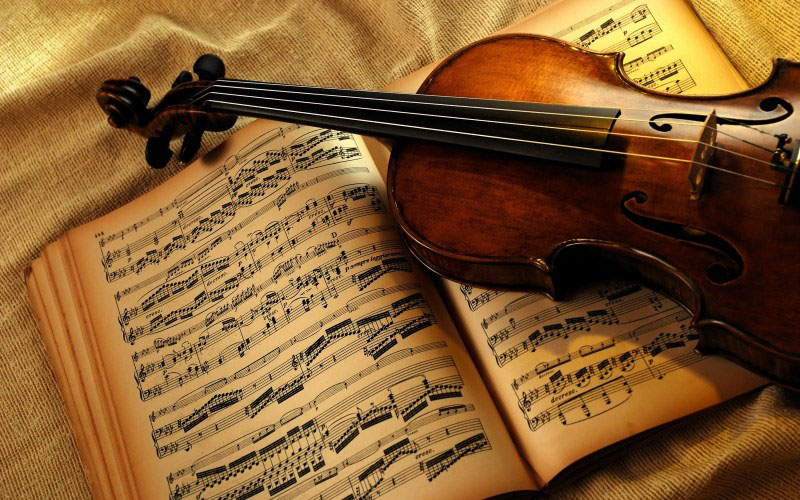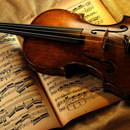Quantum Harmonies: Modern Physics and Music
PBS
Wed September 10, 2014
From Pythagoras to string theory, explore the surprising connections between music and physics.
The universe is built on harmonies. The Pythagoreans had it right when they married mathematics, music, and the cosmos. Just as mathematical patterns underlie the musical scales and intervals most pleasing to the ear, they also describe the probability waves at the heart of quantum theory.
More than 2500 years ago, according to ancient sources, Pythagoras applied his discoveries in music theory to the behavior of the celestial objects. Pluck a string, and the pitch of the note it produces is related to the length of the string. When the lengths of two strings are a simple ratio - 1/2, 2/3, and so on - the notes together sound harmonious. Pythagoras believed that the universe itself hummed with its own harmony - beautiful, divine, and inaudible to human ears. He characterized the intervals between successive orbits, such as those of Mercury and Venus, as either tones or half-tones (the smallest intervals in the musical scale), adding up to seven whole tones that form a perfectly harmonious natural order.
When the French physicist Louis de Broglie proposed the wave nature of electrons and other matter particles, he may very well have had musical harmonics in mind. De Broglie showed how the different energy levels of Niels Bohr’s atomic model emerged naturally by describing electrons as standing waves of various frequencies, thereby generalizing the wave theory of light to material particles. Just as a guitar string can be plucked in certain ways to produce particular sounds, electrons in de Broglie’s scheme are forced to oscillate in particular patterns, corresponding to certain frequencies and energy levels.
Erwin Schrödinger developed de Broglie’s idea further with his famous wave equation, yielding three-dimensional pulsations known as spherical harmonics. Spherical harmonics differ from standing wave patterns because they describe a wider assortment of shapes - spheres, barbells, and so forth - that offer a richer description of electron behavior.
However, as shown by German physicist Max Born , it is not the electrons themselves that display wave patterns, as de Broglie and Schrödinger believed, but rather the probability distributions indicating, for example, their likeliest positions. While neither Schrödinger nor Einstein were comfortable with Born’s statistical interpretation, it has persisted as the standard view.
Superstring theory , a hypothetical attempt to unite the fundamental forces - the gravitational, electroweak and strong forces - applies the idea of harmonics on a far smaller scale than atomic physics, on the order of the Planck length, about 10 -35 meters (compared to about 10 -10 meters for atoms). It replaces point particles with vibrating strands of energy. Various modes of vibration determine the particles’ properties, explaining the diversity of the particle zoo through the complexity of the oscillations and the geometry of the higher-dimensional space in which they are embedded.
So if physicists are tuned in to the music of the universe, are musicians returning the favor? Tears for Fears singer, songwriter, and guitarist Roland Orzabal was inspired to take on the philosophical conundrums of quantum mechanics in the early 1990s, when he began to devour popular science books.
“I became fascinated with where science was headed and all the reality-challenging concepts it was throwing up,” recalled Orzabal. “Wonderful thought experiments such as Schrödinger’s Cat have an almost poetic, visual quality to them, which, as a songwriter, I found inspirational, so much so that I managed to play with the concept in a song of the same name .”
Orzabal was also inspired by Einstein’s famous dismissal of the randomness of quantum mechanics. “’God does not play dice’ is a gift to any songwriter,” said Orzabal, and it inspired a second science-themed song, “ God’s Mistake ” - though to Orzabal, that mistake is the unpredictable outcome of love, not of a physics experiment.
Max Born also embraced the uncertainty at the heart of quantum physics. “I cannot understand how you can combine an entirely mechanistic universe with the freedom of the ethical individual,” Born wrote to Einstein . “To me a deterministic world is quite abhorrent - this is a primary feeling.” Probabilistic quantum mechanics, Orzabal suggests in verse and Born in his letter, doesn’t seem unnatural in the face of a world in which passion and conflict are unforeseeable as well. On the contrary, Einstein’s clockwork ideal appears out of step with tumultuous reality.
Orzabal writes for concert halls, not classrooms; he’s wrestling with the fundamental nature of the universe in the way that comes most naturally to him - music. But other musicians use their art as a science teaching tool. Haverford physicist Walter Smith, who maintains a library of musical physics parodies on his excellent webpage PhysicsSongs.org , points out the educational value of songs related to physics. “Songs about physics can help students to remember critical concepts and formulas, but perhaps more importantly they communicate the lesson that physics can be fun,” says Smith. From satirist Tom Lehrer’s rapid-fire rundown of the periodic table to the celebrated physicist James Clerk Maxwell’s somewhat less celebrated forays into song , physics and music have a long and lively friendship.
Even CERN’s Large Hadron Collider has gotten into the game. In 2008, most non-scientists knew very little about the LHC, except perhaps the irrational misconception that it might create a miniature black hole that would gobble up the Earth. Enter CERN physicist Kate McAlpine , who wrote and performed the “Large Hadron Rap,” a musical rundown of potential LHC discoveries.
“Particle physics is quite esoteric to most people, so I wanted to write lyrics that might give a basic understanding of what this big, expensive machine was for and why it was so exciting,” said McAlpine. “Rhyme is a great memory aid, so if you can get the words and rhythm to stick, understanding can follow even it doesn’t come right away. Many teachers and parents have been in touch to request rap videos for use in classes or tell me how much their children love the ‘Large Hadron Rap.’ I think the biggest thing that the ‘Large Hadron Rap’ might have done among young people is put science on their radar as something other than dissecting animals, mixing things in beakers, and rolling balls down inclined planes.” To date, the video has been watched more than 7.7 million times.
When science and current events cross paths, they may become the subject of folk music. My favorite example is Christine Lavin’s history of Pluto’s planetary status set to verse, entitled “ Planet X .”
As Lavin recounted, “’Planet X’ was inspired by an article in USA Today about Pluto’s planetary status. Halfway through the article I knew there was a song inside the story bustin’ to get loose!”
Music resonates, it pulses, it leaps into our psyches. It offers a safe space for scientists and musicians alike to work through the paradoxes of modern physics, and it can be the spoonful of sugar that helps students learn - and enjoy - physics. Thousands of years after the age of Pythagoras, physicists are still discovering the harmonies of the universe.





 Share your thoughts in the Forum
Share your thoughts in the Forum